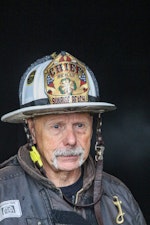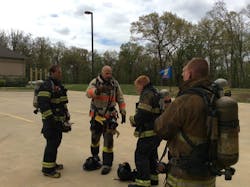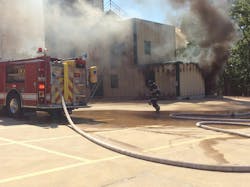If you are a chief who is assigned to shift work, you have a tremendous potential to help to shape the culture of your shift. This can range anywhere from fantastic to horrible.
After spending close to a decade as a chief officer who is assigned to shift work, I have learned many lessons. Here are some tips that will help you to build a solid operational culture.
Tactics and strategy
Attitude is everything, and it’s contagious. People watch you from the moment that you walk through the door until the moment that you leave at the end of the shift. Positive energy begets positive energy, and you shouldn’t diminish the effect that your attitude has on the people who you lead. Firefighters tend to function better in a positive environment. Regardless of how you feel about the organization, the troubles that you might be experiencing in your personal life, or the interpersonal relationships that you are trying to build and manage with your superiors, peers and subordinates, you can’t be seen as the president of the “woe is me” club. It isn’t always easy to be positive, and a fake showing can hurt your credibility, too. When you are having one of those days, temper what you say and don’t allow your bad mood to rub off on anyone else.
Chiefs who are on shift work must be tactically and strategically sound. Consider yourself the chief firefighter. I am not saying that you should pull hose and throw ladders on a regular basis. I am saying that you must be very proficient at all aspects of the fireground. Could you at some point end up having to help to deploy a handline? I would say that, sometimes, the answer is yes. If your skills are weak, everyone who is on your shift probably already knows this, which doesn’t lend itself to building credibility with those who you lead.
On the very next run, you could end up as the incident commander at a wind-driven working apartment fire, with people trapped and a mayday. As much as that single engine company needed your help on the previous run to get its line into operation, everyone on this fireground needs you to make the right calls at the right time.
Some people move from company officer to chief officer based on their past success. I believe that being successful in the company officer role is important, but as a shift work chief, you must go above and beyond. Don’t spend time reliving your past four house fires. Make plans for that wind-driven apartment fire.
Trust
If the standard response to “Where’s the shift chief?” is “In the office,” you might want to rethink your time management. Certainly, there are times when you must be in the office, and that will be understood by your people if it isn’t your default position. That said, your presence is very important to the members of your shift.
A fundamental element to effective tactical operations is a strong sense of trust between all of the members who operate at an incident. Trust is a byproduct of relationships, and relationships aren’t built on absenteeism. Too many chiefs come across as aloof to their members. These chiefs used promotions to isolate themselves from the routine happenings of the firehouse. To be an effective leader, you must be present in the workplace.
The privilege of command might mean that you must structure your day more than the firefighters and officers who are on your shift do. To spend time in the stations and with your members, you might need to spend the hours after supper in your office instead of in the lounge. It’s important for chief officers who are on shift work to maintain an operational/combat focus while also being part of the organization’s executive team. This is very true in smaller organizations that don’t have a large headquarters staff. At some point, the fire chief will lean on your expertise, and you must be able to give what that person needs. In most cases, shift work chiefs are the link between headquarters and the field. If time management isn’t one of your strong suits, you must work on this skill.
Leader or spokesperson?
Often, chiefs, particularly new chiefs, believe that it’s their role to champion all of the different ideas and causes that their members want to pursue. I am not saying that you should dismiss their ideas but that you should use caution. Championing members’ every idea can lead you into a huge conflict with your bosses. For example, say that you’re a newly promoted battalion chief who is assigned to a new command. The members of the command already raised some issue with the fire chief and were turned down. Because you don’t know the backstory, you feel that it’s your role to champion your subordinates’ cause. When you approach the fire chief, you’re greeted with a very pointed and direct question, “Are you part of my leadership team or are you their new spokesperson?”
If you get the feeling that this example comes from an uncomfortable personal experience, you are correct.
No doubt, there are times when you must be ready to go the distance for your people. That said, don’t just think about the issue; think about how it will be received by your boss. How can you present this without weakening your position? Is there a backstory that could affect the discussion? Is this important to all of your members, or is it a cause that’s being championed by only a few? All of these factors must be considered before you act. Just remember that you don’t have to fight all of their battles.
Empowerment
Two of your most important roles are building trust with your members and creating a positive working environment. A good way to do this is to throw them a few “softballs” on a regular basis. There always are things that can help operational effectiveness. Let the members in your command tackle some of these issues. Certainly, you must be prudent when you assign tasks, but giving your people the chance to contribute and to be successful goes a long way toward building the team. As a chief, you should be building the capabilities of your team, and delegating important tasks is a way to do this.
Notice I used important tasks. This shouldn’t be a “window dressing” exercise. You must figure out what’s both important to and doable by the people to which you assign the tasks. Firefighters are very smart, and simple tasks that don’t support the mission might come across as condescending.
Be aware that the softball technique can cause as much harm as good. To avoid this trap, ask some questions along the lines of “What are some things that we must change that will help us on the fireground?” Your subordinates might give you the softballs to lob back to them. This prompts all that much more buy-in and makes this technique all that much more effective.
Some examples of the softballs that I used in the past are:
• Suggesting revisions of an old policy/operating guideline.
• Making the plans for and running a multicompany drill.
• Developing an incident action plan for a high-hazard building and then reviewing the plan with the entire battalion.
Culture
A characteristic of a healthy culture: It respects the history of our service and of the organization. I have been in many firehouses where, if I didn’t know better, I would say that I was at an insurance agency.
Photographs of the members do a world of good for setting the tone and building a solid environment. When you see chiefs and officers in photographs of when they were firefighters, it sends a powerful message. This tells new members that there’s a future for them within the department. It says hard work pays off.
Contrary to what I had an instructor tell me years ago, photographs of major incidents don’t “celebrate our failures.” Those images stand as a reminder of the significance of our job. If you work in suburban America, the big fire might only come every couple of years, but it still can come, and it will be just as bad as a big city fire.
By having these images front and center, you call attention to the reason why the members exist to save lives and property. Go the distance and put in some time, effort and a little bit of your own money to build a sense of a firehouse culture in your department.
Give credit, take blame
When you became a chief, you accepted the fact that, for the right reason, you would step in front of a train for your people. You must be willing to take the blame for what your team does when things don’t go right. I am not saying to condone illegal or immoral behaviors. If this happens, the guilty party is on his or her own (and, hopefully, you made that crystal clear before anything happens).
If you want to lead a team of high-performing professionals, you must provide a safe place for your people to try, fail and then try again. If there is an underlying fear in the ranks about what happens when individuals make a mistake, your part of the organization will end up doing business the exact same way that it was done years ago.
We can’t meet the challenges of today with yesterday’s mindset. Inspirational leaders give credit to their team when things go right and take the blame when things go wrong. So many chiefs fail to see the value of taking blame and giving credit. This is one of the most difficult things to do as a leader, but it also is one of the most important.
Making an impression
Holding a chief officer rank and being assigned to shift work is one of the most rewarding experiences that’s in the fire service. It’s a difficult, and at times a lonely, position that requires much of those who accept the challenge. You must resign yourself to being the last one to sit down and the first one to get up, both literally and figuratively. If you lead from the front, you probably will find your white shirt rather dirty, but remember, the impression that this makes on those who you lead is worth the money that it will cost at the laundry.

Dennis Reilly
Dennis Reilly is a 48-year fire service veteran and retired fire chief and is the owner of The First Line Fire Service Training Company. Reilly served as the fire chief in Pittsburg, KS, and Sunrise Beach, MO, and as an assistant in North Carolina and California and retired as a battalion chief in Cherry Hill, NJ. He was an original member of New Jersey Urban Search and Rescue Task Force 1. Reilly holds a master’s degree in public administration from Penn State University and is a CFO. He has spoken at numerous events, including the Command Officer Boot Camp and the Orlando Fire Conference. Reilly is a U.S. Army veteran who served in Iraq during the Operation Desert Storm.








